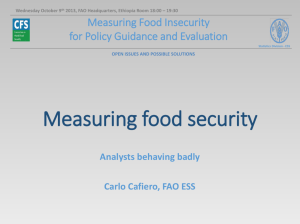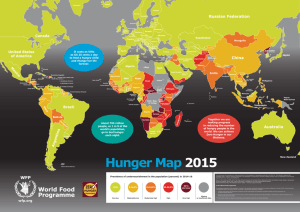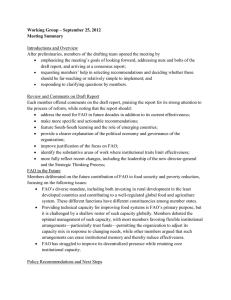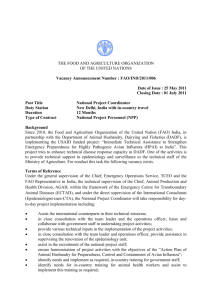Global InItIatIve on Food loss and Waste ReductIon 2015
advertisement
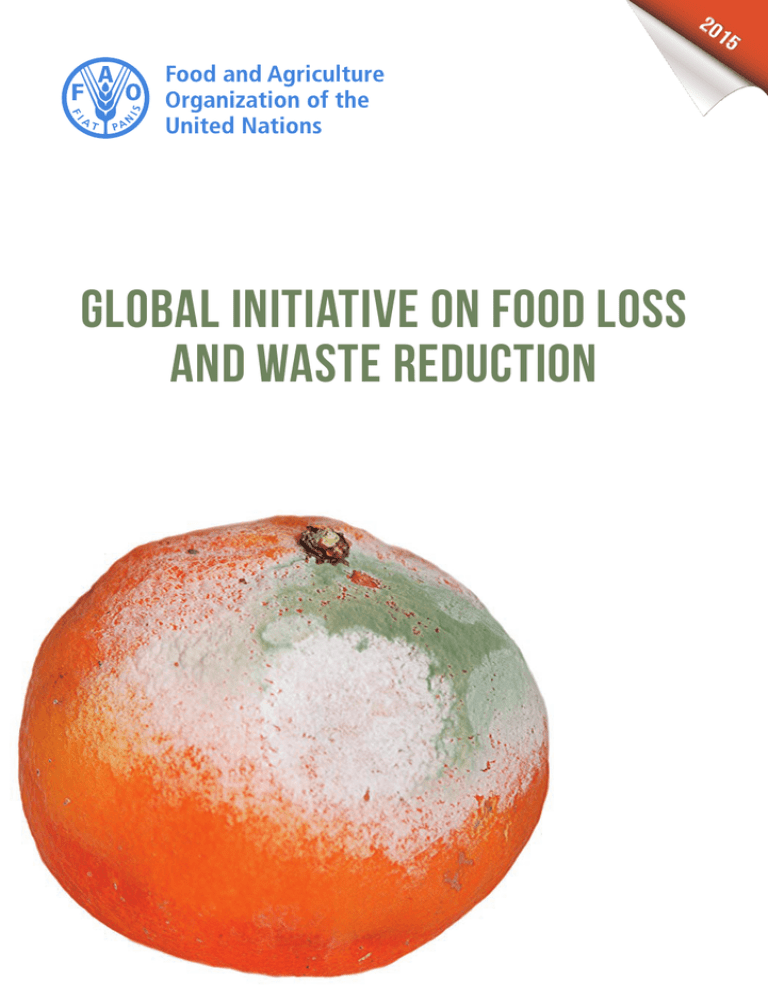
20 15 Global Initiative on Food Loss and Waste Reduction What IS food loss? Food loss is defined as “the decrease in quantity or quality of food” and are the agricultural or fisheries products intended for human consumption that are ultimately not eaten by people or that have incurred a reduction in quality reflected in their nutritional value, economic value or food safety. An important part of food loss is “food waste”, which refers to the discarding or alternative (nonfood) use of food that was fit for human consumption – by choice or after the food has been left to spoil or expire as a result of negligence. Food loss and waste levels are high and depend on specific conditions Accurate estimations of the magnitude of losses and waste are lacking, particularly in developing countries. Nevertheless, there is no doubt that food loss and waste remain unacceptably high. Studies commissioned by FAO estimated yearly global food loss and waste by quantity at roughly 30 percent of cereals, 40 –50 percent of root crops, fruits and vegetables, 20 percent of oilseeds, meat and dairy products, and 35 percent of fish. Food loss and waste are heavily dependent on the specific conditions and local situation in a given country or culture. In low-income countries food loss results from wide-ranging managerial and technical limitations in harvesting techniques, storage, transportation, processing, cooling facilities, infrastructure, packaging and marketing systems. The main sectors of concern are small- and medium-scale fisheries, agricultural production and processing. Social and cultural conditions – such as the different productive and social roles that men and women play at different stages of the value chain – are also often underlying causes of food loss. In rural settings, while women are often the main actors in agriculture, post-harvest handling and marketing, social barriers may block their involvement in other stages of the chain. The difficulties that women face in obtaining access to and benefits from resources, services, jobs and income-generating activities affect their productivity and efficiency in food production, and can lead to food loss. The causes of food waste in medium- and high-income countries relate mainly to consumer behaviour and the policies and regulations put in place to address other sectorial priorities. For example, agricultural subsidies may contribute to the production of surplus quantities of farm crops, of which at least a proportion is lost or wasted. Food safety and quality standards can be applied in ways that remove food that is still safe for human consumption from the food supply chain. At the consumer level, inadequate planning of purchases and failure to use food before its expiry date also lead to avoidable food waste. Global Initiative on Food Loss and Waste Reduction The impacts of food loss and waste are multifaceted Food loss and waste have negative environmental impacts because of the water, land, energy and other natural resources used to produce food that no one consumes. The size of the impact increases with the level of processing and refining of the food products, and the stage (upstream or downstream) in the food supply chain at which the food is lost or wasted. Generally, lower losses are associated with higher efficiency in the food supply, and eventually with more effective recycling of resources, lower storage needs, shorter transport distances, and less energy use. However, solutions for reducing losses often lead to increased use of energy, especially for the preservation of food products. Obviously, from the environmental point of view, the negative impacts of measures to reduce food loss and waste should be lower than the benefits. The non-productive use of natural resources such as land and water that results from food loss and waste has repercussions on hunger and poverty alleviation, nutrition, income generation and economic growth. In the subsistence farming systems of poor smallholder producers, quantitative losses result directly in less food being available, and therefore contribute to food insecurity. Women farmers and young children in many developing countries are particularly likely to suffer this impact, as they often have less access than other groups to appropriate technologies, infrastructure, storage facilities and markets. Qualitative food loss may cause reduced nutritional status, while low-quality products may also be unsafe because of their adverse effects on the health, well-being and productivity of consumers. Food loss represents a loss of economic value economic value for actors in the food production and supply chains. The value of food lost or wasted annually at the global level is estimated at US$ 1 trillion. Today’s food supply chains are increasingly globalized, with certain food items being produced, processed and consumed in very different parts of the world. Food commodities traded on international markets and wasted in one part of the world could affect food availability and prices in other parts. Top ten global greenhouse gas-emitting countries versus food loss and waste, 2005 8 7 5 Mexico United Kingdom Canada Germany Brazil Japan 0 India 1 Russian Federation 2 Food wastage 3 United States of America 4 China Gtonnes CO2 eq. 6 Source: WRI. 2012. Climate Analysis Indicators Tool. Available at: http://cait.wri.org Global Initiative on Food Loss and Waste Reduction Strategies for reducing food loss and waste in a globalized world Because of the magnitude and complexity of the food loss and waste problem, FAO recognizes the need to undertake action in partnership with other regional and international organizations, and with food chain actors ranging from herders, farmers and fishers to global companies. Partnerships are equally important in mobilizing the resources required for action. The approach to reducing food loss and waste is embedded in the broader concept of promoting sustainable food systems, which encompasses sustainable food production on the one hand, and sustainable diets and consumption (such as through the reduction of food waste) on the other. Measures for reducing food loss and waste have to be environmentally sustainable and should foster food and nutrition security. The integrated food supply chain approach takes into account the possibility that food loss and waste in one part of the chain are Global Initiative on Food Loss and Waste Reduction caused in another part. Solutions and strategies focus on systemic improvements of the efficiency and sustainability of food supply chains. From an economic point of view, supply chain actors will adopt food loss and waste reduction measures only if they are profitable or at least cost-effective. Differences in the productive and social roles of men and women actors in supply chains must also be acknowledged and addressed. Addressing food waste: the issue of food waste is high on the political agenda in industrialized countries. Food waste is expected to constitute a growing problem in developing countries given the changes that food systems in these countries are undergoing because of such factors as rapid urbanization, expansion of supermarket chains, and changes in diets and lifestyles. The strategy therefore addresses food waste reduction taking into consideration the need for unique approaches and interventions that differ from those for tackling losses. The Save Food Initiative gives priority to interventions that prevent food loss and waste from occurring in the first place, followed by interventions that can lead to reduced loss and waste. The initiative also supports cost-effective and environmentally friendly reuse (such as for animal feed) and recycling (as compost) of lost and wasted food. The Global Initiative on Food Loss and Waste Reduction is a prominent output of FAO’s new Strategic Framework Because of the need for a multidisciplinary approach, the programme is supported by the FAO divisions involved in agricultural and fisheries production, processing and marketing; consumer protection and nutrition; natural resources; economic and policy development and social protection; statistics; and communications and partnerships. The Save Food Initiative was launched by FAO and Messe Düsseldorf at the Interpack2011 trade fair for the packaging and processing industry, held in Düsseldorf, Germany. The global programme rests on four main pillars: Collaboration and coordination of worldwide initiatives on food loss and waste reduction: Save Food has established a global partnership of public and private sector organizations and companies that are active in the fight against food loss and waste. To develop, plan and implement interventions and use resources efficiently, it is essential that all initiatives are well coordinated, so that everybody knows what is happening worldwide, information, problems and solutions are shared, and methodologies, strategies and approaches are harmonized. Awareness raising on the impact of, and solutions for, food loss and waste: This will be achieved through a global communication and media campaign, the dissemination of findings and results from the Save Food Initiative, and the organization of regional Save Food congresses. Research on policy, strategy and programme development for food loss and waste reduction: This includes a series of national and regional field studies to analyse the causes of, and viable solutions for food loss. The Save Food Initiative also conducts studies on the socio-economic impacts of food loss and waste, and the political and regulatory framework that affects food loss and waste. Support to projects for piloting and implementing food loss reduction strategies by the private and public sectors. The Global Initiative develops regional programmes and supports national implementation Because the causes of food loss and waste vary in different parts of the world, the Save Food Initiative takes a regional approach, developing strategies adjusted to the specific needs of regions, subregions and countries. Collaboration with regional partners is essential. The Save Food regions are: The European Union North America and Australia Japan and the Republic of Korea Eastern Europe and Central Asia North Africa and the Near East Sub-Saharan Africa South and East Asia and the Pacific Latin America and the Caribbean Global Initiative on Food Loss and Waste Reduction The actors – the people and companies, including consumers – involved in food supply chains need to change their management practices, technologies and behaviour to reduce loss and waste. Action by food chain actors is required to reduce food loss and waste The main areas of action are: improved production planning, aligned with markets; promotion of resource-efficient production and processing practices; improved preservation and packing technologies; improved transportation and logistics management; enhanced consciousness of purchasing and consumption habits; ensuring that all chain actors, including women and small producers, receive a fair share of the benefits. In general, these actions require investments by the private sector. Public organizations cannot themselves directly reduce food loss and waste, but they are indispensable in facilitating action from the private sector through: creation of a policy and institutional enabling environment; creation of a favourable investment climate; awareness raising and advocacy; development of partnerships and alliances; support to innovative products and processes; capacity development at the supply chain and institutional levels. Public action is required to support supply chain interventions FAO’s Save Food Initiative is supported by other United Nations organizations, particularly the World Food Programme (WFP), the International Fund for Agricultural Development (IFAD) and the United Nations Environment Programme (UNEP). These organizations work together under the vision of the United Nations Secretary-General’s Zero Hunger Challenge, which has as its fifth element “zero loss or waste of food”. www.un.org/en/zerohunger Global Initiative on Food Loss and Waste Reduction The Save Food Initiative seeks and invites private sector companies and civil society organizations from all over the world to join its network of partners. Save Food promotes collaboration among partners, with each organization contributing its greatest advantages and all complementing each other. Within the network, interactive Communities of Practice are created where partners share and discuss problems and solutions in different sectors, subsectors and regions. The criteria for becoming a Save Food partner are: 1. Active involvement in reducing food loss and/or food waste. 2. Commercial (private) companies or associations that are active in one or more stages of the food supply chain (production, processing, wholesale, retail, restaurant/ catering) or that directly provide goods or services to other actors in the chain (research, input supply, including packaging, management, training, consultancy). Commercial companies, their associations and service providers to commercial companies, are asked to pay a yearly contribution. These funds will be used to support specific activities of the Save Food Initiative such as field studies, publicity and congresses. 3. Non-profit organizations (international development organizations, universities, non-governmental organizations, national institutions, government departments, cooperatives or developing country associations) supporting actors in or development of the food supply chain. Being a partner has benefits: Access to information from and networking with other Save Food partners worldwide. Technical advice and support from FAO and Save Food for programmes to reduce food loss and waste. Links to projects, studies, suppliers and users of services, consultancies, materials, technologies, etc. in the area of food loss and waste reduction. Use of the Save Food Initiative logo. A regular newsletter to which partners can contribute articles on their own initiatives. Partners’ contributions to the Save Food Initiative can include: 1. Sharing information and providing access to other networks related to food loss and/or food waste. 2. Promoting the Save Food Initiative by including the Save Food link on their Web sites. 3. Supporting or contributing to Save Food activities and shaping the Save Food programme. 4. Sponsoring Save Food activities. To join the Save Food Partnership Network please visit our Web site: http://www.fao.org/save-food/get-involved Global Initiative on Food Loss and Waste Reduction Contacts FAO Headquarters SAVE FOOD: Global Initiative on Food Loss and Waste Reduction Food and Agriculture Organization of the United Nations (FAO) Viale delle Terme di Caracalla 00153 Rome, Italy www.fao.org/save-food Save-Food@fao.org +39 06 5705 3674 Regional and Liaison Offices Regional Office for Europe and Central Asia (REU) Budapest, Hungary FAO-RO-Europe@fao.org Regional Office for the Near East and North Africa (RNE) Cairo, Egypt FAO-RNE@fao.org http://neareast.fao.org Regional Office for Africa (RAF) Accra, Ghana FAO-RAF@fao.org Regional Office for Asia and the Pacific (RAP) Bangkok, Thailand FAO-RAP@fao.org www.savefood.net Regional Office for Latin America and the Caribbean (RLC) Santiago, Chile RLC-save-food@fao.org Liaison Office with the European Union (LOB) Brussels, Belgium FAO-LOB@fao.org Liaison Office for North America (LOW) Washington DC, USA FAOLOW@fao.org Liaison Office in Japan (LOJ) Yokohama, Japan FAO-LOJ@fao.org © FAO 2015 Other photos: Wasted apple – ©Koray Food waste for a worm bin – ©J.Bloom Rotten tomatoes – ©N.Bravais Trash bin – ©N.Saltmarsh Produce to be composted – ©J.Bloom Tomato vendors – ©FAO/G.Napolitano Grain storage in metal silo – ©FAO/D.Mejía-Lorío Small metal grain silo – ©FAO/D.Mejía-Lorío Scan the QR codes with your smartphone to visit web pages and download documents. I4068E/4/03.16 Cover photo: Wasted orange – ©A.Termignone


